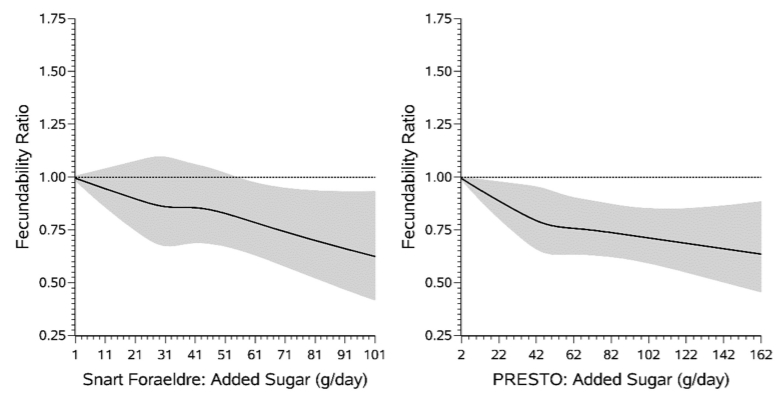Glycemic load, dietary fiber, and added sugar and fecundability in 2 preconception cohorts
Sydney K Willis, The American Journal of Clinical Nutrition, Volume 112, Issue 1, July 2020, Pages 27–38,
Background
Glycemic load (GL) reflects the quantity and quality of carbohydrates in the diet; dietary fiber and added sugar are components of GL. Few epidemiologic studies have assessed the association between these dietary factors and fecundability.
Objective
We prospectively evaluated the associations of GL, total carbohydrates, dietary fiber, and added sugar with fecundability.
Methods
Snart Foraeldre (SF) and Pregnancy Study Online (PRESTO) are parallel web-based prospective preconception cohorts of couples attempting to conceive in Denmark and North America. At baseline, female participants completed a web-based questionnaire on demographic and lifestyle factors and a validated FFQ. We calculated GL, total carbohydrate intake, total dietary fiber, carbohydrate-to-fiber ratio, and added sugar based on reported frequencies for individual foods, standard recipes for mixed foods, and average serving sizes. The analysis included 2709 SF participants and 4268 PRESTO participants. We used proportional probabilities regression models to estimate fecundability ratios (FR) and 95% CIs.
Results
Compared with an average daily GL of ≤100, FRs for an average daily GL of ≥141 were 0.89 (95% CI: 0.73, 1.08) in SF and 0.87 (95% CI: 0.77, 0.98) in PRESTO participants. Compared with consuming ≤16 g/d of dietary fiber, FRs for consuming ≥25 g/d were 0.99 (95% CI: 0.81, 1.22) in SF and 1.06 (95% CI: 0.94, 1.20) in PRESTO. Compared with a carbohydrate-to-fiber ratio of ≤8, FRs for a ratio of ≥13 were 0.86 (95% CI: 0.73, 1.01) in SF and 0.87 (95% CI: 0.78, 0.98) in PRESTO. Compared with ≤27 g/d of added sugar, FRs for ≥72 g/d were 0.87 (95% CI: 0.68, 1.10) in SF and 0.86 (95% CI: 0.75, 0.99) in PRESTO participants.
Conclusions
Among women attempting to conceive in Denmark and North America, diets high in GL, carbohydrate-to-fiber ratio, and added sugar were associated with modestly reduced fecundability.














